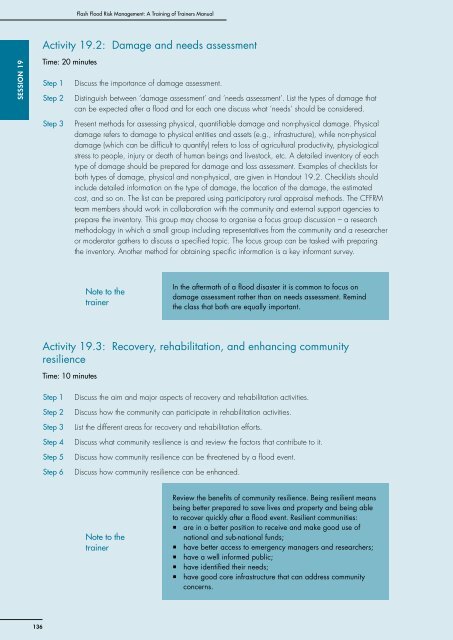Flash Flood Risk Management â A Training of Trainers ... - ReliefWeb
Flash Flood Risk Management â A Training of Trainers ... - ReliefWeb
Flash Flood Risk Management â A Training of Trainers ... - ReliefWeb
You also want an ePaper? Increase the reach of your titles
YUMPU automatically turns print PDFs into web optimized ePapers that Google loves.
<strong>Flash</strong> <strong>Flood</strong> <strong>Risk</strong> <strong>Management</strong>: A <strong>Training</strong> <strong>of</strong> <strong>Trainers</strong> Manual<br />
Activity 19.2: Damage and needs assessment<br />
Session 19<br />
Time: 20 minutes<br />
Step 1<br />
Step 2<br />
Discuss the importance <strong>of</strong> damage assessment.<br />
Distinguish between ‘damage assessment’ and ‘needs assessment’. List the types <strong>of</strong> damage that<br />
can be expected after a flood and for each one discuss what ‘needs’ should be considered.<br />
Step 3<br />
Present methods for assessing physical, quantifiable damage and non-physical damage. Physical<br />
damage refers to damage to physical entities and assets (e.g., infrastructure), while non-physical<br />
damage (which can be difficult to quantify) refers to loss <strong>of</strong> agricultural productivity, physiological<br />
stress to people, injury or death <strong>of</strong> human beings and livestock, etc. A detailed inventory <strong>of</strong> each<br />
type <strong>of</strong> damage should be prepared for damage and loss assessment. Examples <strong>of</strong> checklists for<br />
both types <strong>of</strong> damage, physical and non-physical, are given in Handout 19.2. Checklists should<br />
include detailed information on the type <strong>of</strong> damage, the location <strong>of</strong> the damage, the estimated<br />
cost, and so on. The list can be prepared using participatory rural appraisal methods. The CFFRM<br />
team members should work in collaboration with the community and external support agencies to<br />
prepare the inventory. This group may choose to organise a focus group discussion – a research<br />
methodology in which a small group including representatives from the community and a researcher<br />
or moderator gathers to discuss a specified topic. The focus group can be tasked with preparing<br />
the inventory. Another method for obtaining specific information is a key informant survey.<br />
Note to the<br />
trainer<br />
In the aftermath <strong>of</strong> a flood disaster it is common to focus on<br />
damage assessment rather than on needs assessment. Remind<br />
the class that both are equally important.<br />
Activity 19.3: Recovery, rehabilitation, and enhancing community<br />
resilience<br />
Time: 10 minutes<br />
Step 1<br />
Step 2<br />
Step 3<br />
Step 4<br />
Step 5<br />
Step 6<br />
Discuss the aim and major aspects <strong>of</strong> recovery and rehabilitation activities.<br />
Discuss how the community can participate in rehabilitation activities.<br />
List the different areas for recovery and rehabilitation efforts.<br />
Discuss what community resilience is and review the factors that contribute to it.<br />
Discuss how community resilience can be threatened by a flood event.<br />
Discuss how community resilience can be enhanced.<br />
Note to the<br />
trainer<br />
Review the benefits <strong>of</strong> community resilience. Being resilient means<br />
being better prepared to save lives and property and being able<br />
to recover quickly after a flood event. Resilient communities:<br />
• are in a better position to receive and make good use <strong>of</strong><br />
national and sub-national funds;<br />
• have better access to emergency managers and researchers;<br />
• have a well informed public;<br />
• have identified their needs;<br />
• have good core infrastructure that can address community<br />
concerns.<br />
136

















